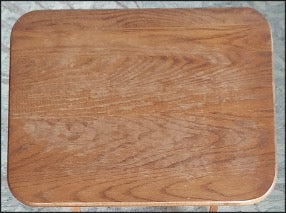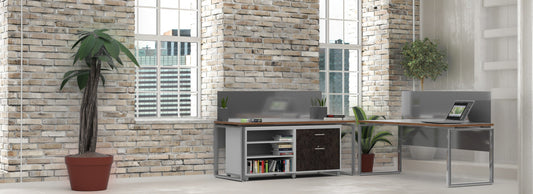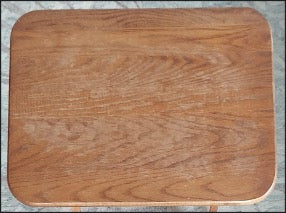
5 Common Mistakes People Make When Caring for Wood Furniture (And How to Avoid Them)
Share
Wood furniture is a beautiful, timeless addition to any home or space. However, improper care can quickly lead to damage, dullness, and even costly repairs. By learning how to avoid these common wood-care mistakes, you can ensure your furniture remains stunning for years to come. Here are five pitfalls to watch out for and how Arlington Woodworks Artisan Furniture Wood Balm can help repair and protect your treasured pieces.
Mistake 1: Using Harsh Chemical Cleaners

Many people turn to household cleaners that contain harsh chemicals or abrasives when cleaning their wood furniture. Unfortunately, these products can strip the wood’s natural finish, causing discoloration and damage over time. Using harsh chemical cleaners on wood furniture is bad because they can strip away the protective finish on the wood, causing damage like discoloration, warping, and even exposing the raw wood underneath, which can lead to further deterioration over time; essentially, the chemicals can dissolve the wood's finish, leaving it vulnerable to moisture and other elements.
Key reasons why harsh chemicals are harmful to wood furniture:
- Stripping the finish: Many chemical cleaners contain strong solvents that can dissolve the wax, varnish, or polyurethane coating on the wood, leaving it unprotected.
- Moisture damage: Once the finish is compromised, the wood can absorb moisture, causing swelling and warping.
- Discoloration: Chemicals can also react with the wood pigments, leading to uneven discoloration or bleaching.
- Abrasive effects: Some harsh cleaners may contain abrasive particles that can scratch the wood surface, especially if rubbed vigorously.
Examples of chemicals to avoid on wood furniture:
- Ammonia: Can damage the wood finish and cause discoloration
- Bleach: Highly corrosive and can severely damage the wood
- Acetone: Strong solvent that can strip away the finish
- Commercial glass cleaners: Often contain harsh chemicals not suitable for wood
How to Avoid It: Use a gentle, natural cleaner or simply wipe down your furniture with a damp, lint-free cloth.
What to use instead:
- Mild soap and water: A gentle soap solution is usually sufficient for routine cleaning of wood furniture.
- Wood cleaner specifically designed for wood: Opt for commercially available wood cleaners that are formulated to clean without damaging the finish. (Method Daily Wood Cleaner is a good option, and what we use around the house.)
- Wood polish or wax: Apply a thin layer of wood polish or wax regularly to maintain the protective finish and prevent moisture damage. For added protection and nourishment, regularly apply a high-quality wood finish like Arlington Woodworks Artisan Furniture Wood Balm to restore the wood’s natural beauty and safeguard it against future damage.
For more information on how to properly clean your wood furniture, check out this article. It also provides a recipe for how to make a soapy water solution for cleaning your wooden furniture.
Mistake 2: Neglecting to Dust Regularly

Dust might seem harmless, but when it accumulates on wood furniture, it can act like sandpaper, scratching the surface and dulling the finish. Neglecting to dust wood furniture regularly is bad because dust particles can act like fine sandpaper, gradually scratching the wood's finish, causing visible wear and tear over time, and potentially damaging the protective layer on the wood, especially when combined with moisture or other debris; essentially, the buildup of dust can dull the wood's appearance and shorten its lifespan.
Key points about dust and wood furniture:
- Abrasive nature: Dust particles are small and can scratch the wood surface when left to accumulate.
- Moisture trap: Dust can trap moisture, which can lead to warping or staining on the wood.
- Difficult removal: The longer dust sits, the harder it can be to remove, potentially requiring harsher cleaning methods that could damage the finish.
- Aesthetic impact: A buildup of dust makes wood furniture look dull and dirty.
How to Avoid It: To maintain the quality of your wood furniture, it's recommended to dust it regularly with a soft, clean cloth to prevent dust accumulation. A little effort on a consistent basis can go a long way to keeping your furniture in a like new condition. In addition to dusting, we add our high quality organic finish/polish to the routine a couple times a year or when the furniture is starting to look dull due to daily use.
Mistake 3: Exposing Wood to Excess Moisture

Exposing wood to excess moisture is bad for wood furniture because wood is a porous material that readily absorbs water, causing it to swell, warp, and potentially crack or rot, significantly impacting the structural integrity and appearance of the furniture due to uneven expansion and contraction as the moisture levels change in the surrounding environment; essentially, too much moisture can lead to significant dimensional changes in the wood, damaging its stability and causing visible defects. Spills, condensation from drinks, or cleaning with too much water can also cause wood to swell, warp, or develop unsightly stains.
Key points about why excess moisture harms wood furniture:
- Swelling and shrinking: When wood absorbs moisture, it expands, and when it dries out, it shrinks, which can lead to warping, cupping, and gaps between joints if the moisture fluctuations are significant.
- Joint disruption: Swelling from excess moisture can put pressure on joints in furniture, potentially causing them to loosen or break apart.
- Mold and mildew growth: High moisture levels create an ideal environment for mold and mildew to grow on the wood surface, further damaging the furniture.
- Wood rot: In extreme cases, prolonged exposure to excessive moisture can lead to wood rot, where the wood fibers begin to decompose.
Tips to protect wood furniture from moisture damage:
- Maintain proper humidity levels: Use a dehumidifier in humid environments to control moisture levels in your home.
- Apply protective finishes: Regularly apply a quality wood finish to seal the wood and minimize moisture absorption.
- Avoid direct water contact: Wipe up spills immediately and protect furniture from direct water splashes.
- Place furniture away from heat sources: Excessive heat can also damage wood, so keep furniture away from radiators or fireplaces.
How to Avoid It: Always use coasters and clean up spills immediately. Avoid saturating the wood with water when cleaning. If your furniture has already sustained water damage, applying Arlington Woodworks Artisan Furniture Wood Balm can help rejuvenate the surface and provide lasting protection against moisture. Regular application of a high-quality natural wood finish will protect your furniture and help prevent future damage.
Mistake 4: Ignoring Sunlight Damage

Prolonged exposure to sunlight can fade the color of wood furniture and dry out its finish, leaving it vulnerable to cracking. Ignoring sunlight damage is bad for wood furniture because the UV rays in sunlight can cause the wood to fade, discolor, crack, warp, and deteriorate over time, significantly impacting both the appearance and structural integrity of the piece, potentially rendering it unusable if left untreated; essentially, prolonged sun exposure can permanently damage the wood fibers, making it more prone to further degradation.
Key points about sunlight damage to wood furniture:
- UV rays are the culprit: The primary damaging component of sunlight is ultraviolet radiation (UV), which breaks down the lignin in wood, causing discoloration and weakening the fibers.
- Visible effects: Sun exposure can lead to noticeable changes like fading of the wood's natural color, uneven darkening, and surface cracking.
- Structural concerns: In severe cases, prolonged sun exposure can cause warping and cupping of the wood, affecting the furniture's stability and functionality.
Tips to prevent sun damage to wood furniture:
- Position furniture strategically: Place furniture away from direct sunlight by using curtains, blinds, or strategically positioning it within a room.
- Use protective finishes: Apply a high-quality wood finish with UV protection to shield the wood from harmful rays.
- Regular maintenance: Periodically reapply finish to maintain its protective layer.
- Consider covers: For outdoor furniture, use protective covers when not in use to block sunlight.
How to Avoid It: Position your furniture away from direct sunlight or use window treatments like curtains or blinds to limit exposure. Applying a protective finish can help shield your furniture from UV rays while enhancing its natural beauty. Regularly reapply finish for furniture that is exposed to UV rays on a consistent basis.
Mistake 5: Skipping Regular Maintenance

Wood furniture requires consistent care to stay in top condition. Neglecting to periodically reapply a protective finish can leave the surface dull, dry, and prone to damage.
How to Avoid It: Make wood care part of your routine. Reapply as needed to keep your furniture looking its best and to protect it from everyday wear and tear.
Protect and Rejuvenate Your Wood Furniture
Caring for wood furniture doesn’t have to be complicated. By avoiding these common mistakes and using Arlington Woodworks Artisan Furniture Wood Balm, you can ensure your furniture remains beautiful and protected for years to come. Made with 100% organic ingredients, our eco-friendly wood finish is safe for your home and the environment, providing the perfect solution to repair and prevent damage naturally.

Check out our wood balm today and give your furniture the care it deserves!




1 comment
Great points on the long-term value of <a href=‘’https://pinkyfurniture.com/’‘> wooden furniture . I’d add that everyone should understand the common mistakes to avoid when buying or caring for solid wood furniture to truly protect their investment. Check this guide ’‘https://pinkyfurniture.com/blogs/pinky-blogs/top-mistakes-to-avoid-when-buying-or-caring-for-solid-wood-furniture’’> Top mistakes to avoid